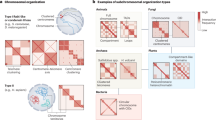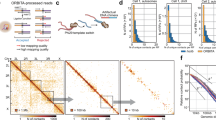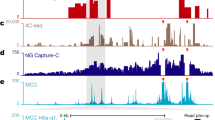Abstract
The spatial organization of the genome is intimately linked to its biological function, yet our understanding of higher order genomic structure is coarse, fragmented and incomplete. In the nucleus of eukaryotic cells, interphase chromosomes occupy distinct chromosome territories, and numerous models have been proposed for how chromosomes fold within chromosome territories1. These models, however, provide only few mechanistic details about the relationship between higher order chromatin structure and genome function. Recent advances in genomic technologies have led to rapid advances in the study of three-dimensional genome organization. In particular, Hi-C has been introduced as a method for identifying higher order chromatin interactions genome wide2. Here we investigate the three-dimensional organization of the human and mouse genomes in embryonic stem cells and terminally differentiated cell types at unprecedented resolution. We identify large, megabase-sized local chromatin interaction domains, which we term ‘topological domains’, as a pervasive structural feature of the genome organization. These domains correlate with regions of the genome that constrain the spread of heterochromatin. The domains are stable across different cell types and highly conserved across species, indicating that topological domains are an inherent property of mammalian genomes. Finally, we find that the boundaries of topological domains are enriched for the insulator binding protein CTCF, housekeeping genes, transfer RNAs and short interspersed element (SINE) retrotransposons, indicating that these factors may have a role in establishing the topological domain structure of the genome.
This is a preview of subscription content, access via your institution
Access options
Subscribe to this journal
Receive 51 print issues and online access
$199.00 per year
only $3.90 per issue
Buy this article
- Purchase on SpringerLink
- Instant access to full article PDF
Prices may be subject to local taxes which are calculated during checkout




Similar content being viewed by others
Accession codes
Primary accessions
Gene Expression Omnibus
Data deposits
All Hi-C data described in this study have been deposited in the GEO under accession number GSE35156. We have developed a web-based Java tool to visualize the high-resolution Hi-C data at a genomic region of interest that is available at http://chromosome.sdsc.edu/mouse/hi-c/.
References
Cremer, T. & Cremer, M. Chromosome territories. Cold Spring Harb. Perspect. Biol. 2, a003889 (2010)
Lieberman-Aiden, E. et al. Comprehensive mapping of long-range interactions reveals folding principles of the human genome. Science 326, 289–293 (2009)
Yaffe, E. & Tanay, A. Probabilistic modeling of Hi-C contact maps eliminates systematic biases to characterize global chromosomal architecture. Nature Genet. 43, 1059–1065 (2011)
Wang, K. C. et al. A long noncoding RNA maintains active chromatin to coordinate homeotic gene expression. Nature 472, 120–124 (2011)
Kagey, M. H. et al. Mediator and cohesin connect gene expression and chromatin architecture. Nature 467, 430–435 (2010)
Eskeland, R. et al. Ring1B compacts chromatin structure and represses gene expression independent of histone ubiquitination. Mol. Cell 38, 452–464 (2010)
Noordermeer, D. et al. The dynamic architecture of Hox gene clusters. Science 334, 222–225 (2011)
Kim, Y. J., Cecchini, K. R. & Kim, T. H. Conserved, developmentally regulated mechanism couples chromosomal looping and heterochromatin barrier activity at the homeobox gene A locus. Proc. Natl Acad. Sci. USA 108, 7391–7396 (2011)
Phillips, J. E. & Corces, V. G. CTCF: master weaver of the genome. Cell 137, 1194–1211 (2009)
Guelen, L. et al. Domain organization of human chromosomes revealed by mapping of nuclear lamina interactions. Nature 453, 948–951 (2008)
Handoko, L. et al. CTCF-mediated functional chromatin interactome in pluripotent cells. Nature Genet. 43, 630–638 (2011)
Xie, W. et al. Base-resolution analyses of sequence and parent-of-origin dependent DNA methylation in the mouse genome. Cell 148, 816–831 (2012)
Hawkins, R. D. et al. Distinct epigenomic landscapes of pluripotent and lineage-committed human cells. Cell Stem Cell 6, 479–491 (2010)
Peric-Hupkes, D. et al. Molecular maps of the reorganization of genome-nuclear lamina interactions during differentiation. Mol. Cell 38, 603–613 (2010)
Hiratani, I. et al. Genome-wide dynamics of replication timing revealed by in vitro models of mouse embryogenesis. Genome Res. 20, 155–169 (2010)
Ryba, T. et al. Evolutionarily conserved replication timing profiles predict long-range chromatin interactions and distinguish closely related cell types. Genome Res. 20, 761–770 (2010)
Wen, B., Wu, H., Shinkai, Y., Irizarry, R. A. & Feinberg, A. P. Large histone H3 lysine 9 dimethylated chromatin blocks distinguish differentiated from embryonic stem cells. Nature Genet. 41, 246–250 (2009)
Scott, K. C., Taubman, A. D. & Geyer, P. K. Enhancer blocking by the Drosophila gypsy insulator depends upon insulator anatomy and enhancer strength. Genetics 153, 787–798 (1999)
Bilodeau, S., Kagey, M. H., Frampton, G. M., Rahl, P. B. & Young, R. A. SetDB1 contributes to repression of genes encoding developmental regulators and maintenance of ES cell state. Genes Dev. 23, 2484–2489 (2009)
Marson, A. et al. Connecting microRNA genes to the core transcriptional regulatory circuitry of embryonic stem cells. Cell 134, 521–533 (2008)
Min, I. M. et al. Regulating RNA polymerase pausing and transcription elongation in embryonic stem cells. Genes Dev. 25, 742–754 (2011)
Donze, D. & Kamakaka, R. T. RNA polymerase III and RNA polymerase II promoter complexes are heterochromatin barriers in Saccharomyces cerevisiae . EMBO J. 20, 520–531 (2001)
Ebersole, T. et al. tRNA genes protect a reporter gene from epigenetic silencing in mouse cells. Cell Cycle 10, 2779–2791 (2011)
Lunyak, V. V. et al. Developmentally regulated activation of a SINE B2 repeat as a domain boundary in organogenesis. Science 317, 248–251 (2007)
Schmidt, D. et al. Waves of retrotransposon expansion remodel genome organization and CTCF binding in multiple mammalian lineages. Cell. 148, 335–348 (2012)
Jhunjhunwala, S. et al. The 3D structure of the immunoglobulin heavy-chain locus: implications for long-range genomic interactions. Cell 133, 265–279 (2008)
Capelson, M. & Corces, V. G. Boundary elements and nuclear organization. Biol. Cell 96, 617–629 (2004)
Amouyal, M. Gene insulation. Part I: natural strategies in yeast and Drosophila . Biochem. Cell Biol. 88, 875–884 (2010)
Sexton, T. et al. Three-dimensional folding and functional organization principles of the Drosophila genome. Cell 148, 458–472 (2012)
Nora, E. P. et al. Spatial partitioning of the regulatory landscape of the X-inactivation centre. Nature http://dx.doi.org/10.1038/nature11049 (this issue)
Acknowledgements
We are grateful for the comments from and discussions with Z. Qin, A. Desai and members of the Ren laboratory during the course of the study. We also thank W. Bickmore and R. Eskeland for sharing the FISH data generated in mouse ES cells. This work was supported by funding from the Ludwig Institute for Cancer Research, California Institute for Regenerative Medicine (CIRM, RN2-00905-1) (to B.R.) and NIH (B.R. R01GH003991). J.R.D. is funded by a pre-doctoral training grant from CIRM. Y.S. is supported by a postdoctoral fellowship from the Rett Syndrome Research Foundation.
Author information
Authors and Affiliations
Contributions
J.R.D. and B.R. designed the studies. J.R.D., A.K., Y.L. and Y.S. conducted the Hi-C experiments; J.R.D., S.S. and F.Y. carried out the data analysis; J.S.L. and M.H. provided insight for analysis; F.Y. built the supporting website; J.R.D. and B.R. prepared the manuscript.
Corresponding author
Ethics declarations
Competing interests
The authors declare no competing financial interests.
Supplementary information
Supplementary Information
This file contains Supplementary Datasets, Supplementary Methods, Supplementary References, Supplementary Figures 1–28 and Supplementary Tables 1 and 2. (PDF 6151 kb)
Supplementary Table
This file contains Supplementary Table 3. (XLS 1718 kb)
Supplementary Table
This file contains Supplementary Table 4. (XLS 1507 kb)
Supplementary Table
This file contains Supplementary Table 5. (XLS 473 kb)
Supplementary Table
This file contains Supplementary Table 6. (XLS 875 kb)
Supplementary Table
This file contains Supplementary Table 7. (XLS 318 kb)
Supplementary Table
This file contains Supplementary Table 8. (XLS 89 kb)
Supplementary Table
This file contains Supplementary Table 9. (XLS 117 kb)
Supplementary Table
This file contains Supplementary Table 10. (XLS 203 kb)
Rights and permissions
About this article
Cite this article
Dixon, J., Selvaraj, S., Yue, F. et al. Topological domains in mammalian genomes identified by analysis of chromatin interactions. Nature 485, 376–380 (2012). https://doi.org/10.1038/nature11082
Received:
Accepted:
Published:
Issue Date:
DOI: https://doi.org/10.1038/nature11082
This article is cited by
-
Transcriptionally active chromatin loops contain both ‘active’ and ‘inactive’ histone modifications that exhibit exclusivity at the level of nucleosome clusters
Epigenetics & Chromatin (2024)
-
Giant pandas in captivity undergo short-term adaptation in nerve-related pathways
BMC Zoology (2024)
-
Emergence of replication timing during early mammalian development
Nature (2024)
-
Kdm1a safeguards the topological boundaries of PRC2-repressed genes and prevents aging-related euchromatinization in neurons
Nature Communications (2024)
-
DiffDomain enables identification of structurally reorganized topologically associating domains
Nature Communications (2024)



